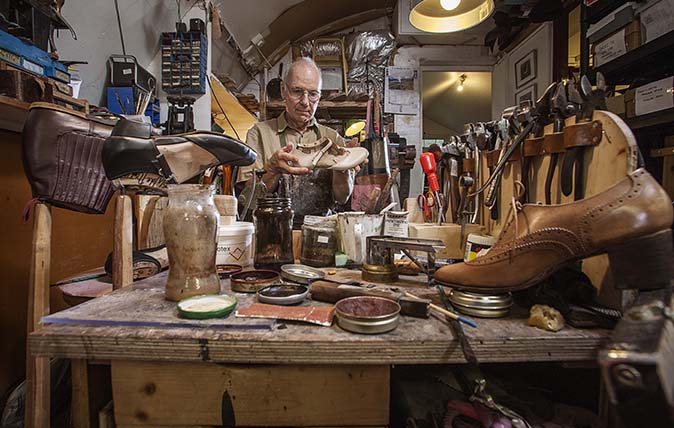John Goodall meets Bill Bird, who, having studied architecture at the Bartlett, now makes orthopaedic shoes. Photographs by Richard Cannon.
Bill Bird was born with a mild foot deformity, which, he explains, drew him into orthopaedic shoe-making. ‘Shoes can make a huge difference and I aim to make ones that not only work, but also look beautiful,’ he says.
In 1979, having studied architecture at the Bartlett, Mr Bird became an apprentice at John Lobb Ltd of St James’s Street, SW1, bootmakers by Royal Appointment. The same year, he also started to study biomechanics and podiatry.
‘I quickly realised that podiatrists knew what to do in a medical sense, but didn’t know how to do it and that shoe-makers were uncertain as to what was needed, so I decided to bridge the disciplines,’ he says.

Orthopaedic shoemaker Bill Bird of Bill Bird Shoes.
Mr Bird set up his company in 1987 and, today, the five-strong workshop produces about five pairs of shoes a week, from dance shoes to fell boots. The lasts he uses – the wooden blocks that the shoes are made around – are made in the traditional way using a ‘draft’: by tracing around the foot with the pencil held vertically, an outline of the instep taken with the pencil at 45° and a series of measurements.
‘By palpating the foot, we find, then measure, the circumference of six specific structures, thereby getting a deep, felt sense of the foot’s shape and how it works,’ he adds.
He used to carve the lasts from German beech wood, but now opts for local timber such as holly, ash and hornbeam.
No less important is the prescription: ‘There are many different technical decisions to be taken. We might take foot impressions, photographs or digital measurements. An inkpad can also reveal where pressure is being exerted.’
Mr Bird reflects that his aim is to make his workshop run without him: ‘I’m 67 and I need to make myself redundant. If something happens to me, this must carry on.’

The fan maker: ‘If you can fold a piece of paper, you can do it’
Caroline Allington is one of three people in the UK known for the heritage craft of fan-making. She explains to

Humphry Repton: How the legendary gardener embodied the spirit of his age
The leading garden-maker at the turn of the 19th century, Humphry Repton (1752–1818) was a man of feeling, as well

On top of the world: The painstaking, intricate art of globe-making
After years as little-used antiques hidden in dusty libraries, Bellerby & Co is putting handcrafted globes back on the map.





